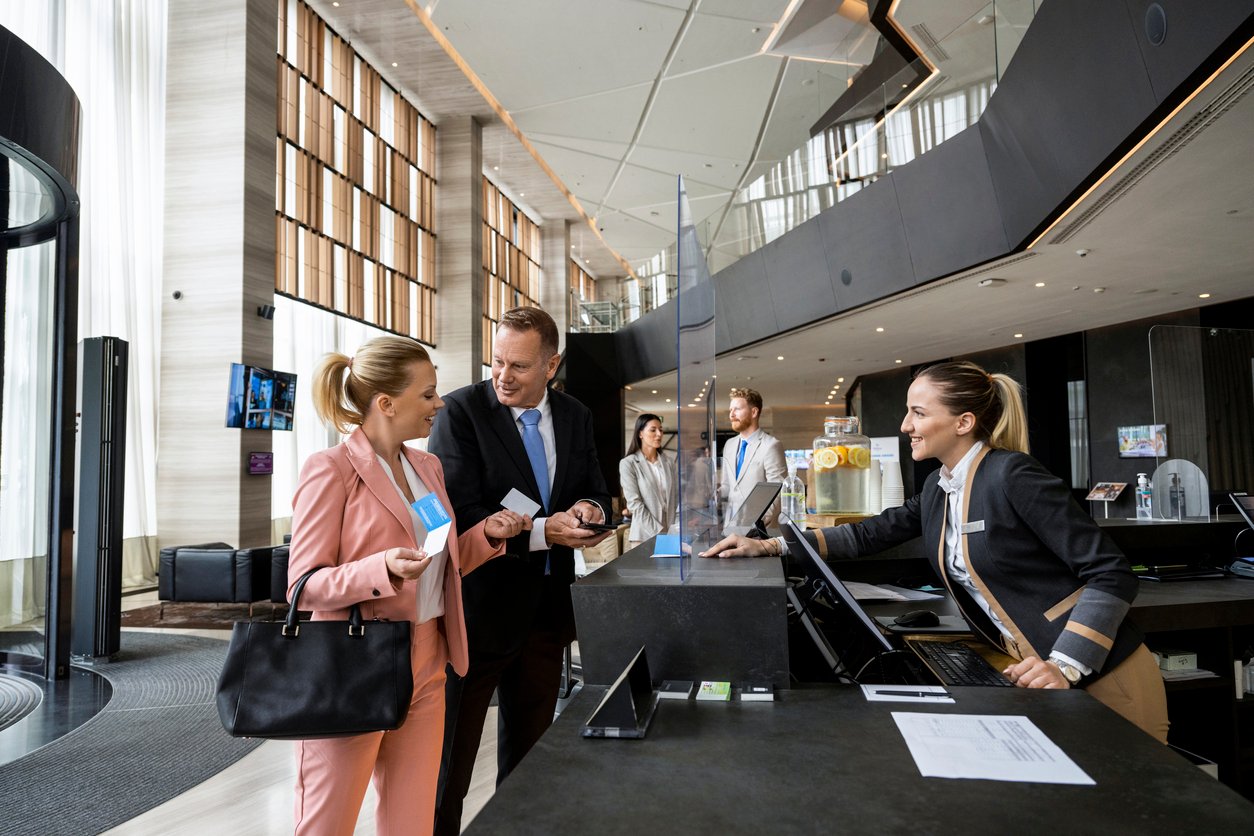A Deep Dive Into Developing a Dynamic Pricing Strategy in Hotels
Static pricing and seasonal room rates are no longer the frontrunners in maximizing revenue and boosting profitability...

Table of Contents
Markets in the hotel industryconsistently fluctuate because of changes in supply and demand, usually because of seasonality, shifts in economics, weather, changes in the transportation industry (e.g., airlines), and much more. This is a fact hotel revenue managers must be aware of to keep up with the latest trends and to establish the right rates.
If you’re a traditional hotelier who still prefers seasonal room rates, you’re looking at lost profit optimization and decreased revenue. Good luck dealing with your hotel’s RevPar and ADR.
Because of the constant changes in guest demands, you must be able to adopt effective revenue strategies to maximize profitability.
That is why implementing hotel dynamic pricing strategies is so essential in the hospitality industry. These strategies can help hotels stay in business, even during uncertain times. This includes using software to manage all the possible fluctuations and scenarios affecting prices.
What are hotel dynamic pricing strategies, and why do they matter? Let’s talk about it in this comprehensive guide.
The traditional way of selling rooms was offering them at flat rates that remained fixed over time. These prices were almost always established in advance, and hoteliers were not used to adjusting them based on the changes in demand and marketing conditions.
And while traditional pricing worked for a while, today’s world is full of rapidly-changing supply and demand landscapes that can change on a dime, thanks to digitization. Dynamic pricing in hotels accounts for demand fluctuations, no matter what they are caused by.
Software like HouseCount RMS works at all times, even while you are sleeping, to provide the best pricing recommendations based on a wide variety of current and historical data. By utilizing the information gleaned from historical trends and patterns and considering current data, the system can provide the most educated and tailored pricing recommendations that only improve over time.
The software does this by considering:
Dynamic pricing also considers various factors affecting market demand and its fluctuations. These factors include:
Understanding how dynamic pricing in hotels enhances overall hotel revenue is crucial. Dynamic pricing aims to optimize room occupancy by adjusting room rates, naturally increasing revenue.
Dynamic pricing software is able to achieve this goal because of diligent monitoring of past and current market trends and patterns while also considering current data. This approach enables hotels to maximize their revenue per available room (RevPAR) by aligning their room rates with the prevailing market value.
Another effective method that dynamic pricing software uses to boost hotel revenue is the "U" pricing strategy. This strategy involves offering rooms at a lower price during a specific period leading up to the booking date. As the date approaches, the hotel can quote higher prices in response to the growing demand.
Furthermore, dynamic pricing empowers hotels to set rates based on their guests' willingness to pay. This creates a win-win situation where guests feel content with the price they pay, and the hotel simultaneously maximizes its room occupancy.
Moreover, dynamic pricing allows hotels to manage the prices of unsold rooms, reducing the likelihood of these rooms remaining vacant, regardless of the season. The crucial point to remember is that increased room occupancy directly correlates with the potential for higher revenue.
You can generally employ two main pricing strategies for your hotel: fixed and dynamic.
Knowing which strategy is more appropriate means understanding their differences and significant implications.
|
Static Pricing |
Dynamic Pricing |
|
Room rates remain the same over a certain period of time. |
Room rates fluctuate and are time-based. |
|
Trends, market fluctuations, occupancies, and demands are not dynamically taken into consideration when setting pricing. Instead, prices are generally set considering seasonability only. |
Prices change based on overall demand, occupancy, and other market trends. |
|
Hotels know the market well and constantly monitor yearly trends. |
Focus more on area demand and supply, capturing more businesses. |
|
Can restrict increasing overall profit by the number of volumes sold. |
More flexible in increasing your profits. |
|
No direct interaction with data systems for accurate forecasting. |
Automated systems can adjust room rates based on data forecasting. |
The main benefit of dynamic hotel pricing is allowing your property to capture and attract more occupancy by offering more competitive rates based on fluctuations in market demands.
For example, if your hotel is near a stadium or event center, and a big concert will be held over the weekend, why not take advantage of that event and charge higher rates for your rooms?
Guests will likely book your hotel regardless of the price increase due to your hotel’s proximity to the event. With this strategy, you’re leveraging the ability to charge higher rates as possible, allowing your rooms to be occupied with competitive prices in times when it matters most.
Dynamic pricing software like HouseCount RMS automates the price adjustment process by considering past and current market conditions and a wide variety of other factors, like seasonality. The ability to automate pricing reduces the need for manual input from your revenue manager and allows pricing adjustments to be made anytime, even during off hours.. This frees up more time for your manager to focus on other strategy work for your hotel.
Dynamic hotel pricing can also give you insights into market trends and guest behavior.

Dynamic hotel pricing means consistently adjusting room rates based on specific mathematical algorithms. The rate changes will increase room occupancy based on your area's demand. Revenue managers must assess and understand your hotel guests and their behavior to ensure accurate algorithms are evaluated.
Dynamic pricing algorithms must focus on the following aspects:
Moreover, hotel revenue managers must also understand market segment performance, shoulder seasons, peak and off-seasons, and areawide special events.
Market research is also critical because it allows your team to understand better what your guests are looking for. It also helps in anticipating and forecasting market fluctuations.
When you understand how market fluctuations affect your room rates, you can develop better strategies to increase your occupancy, ADR, and RevPAR.
Dynamic pricing in hotels is much like any other strategy, which means it has its fair share of pros and cons. Even with the disadvantages, how well your revenue manager can compensate for them can impact the effect of dynamic pricing on your overall profitability, revenue, and performance.
One of the advantages of hotel dynamic pricing is increasing demand for your room rates. Hotel revenue managers can leverage this strategy to attract market segments who are usually uninterested in your hotel rooms.
As a result, you’re able to expand your customer base, which increases revenue potential and minimizes lost sales opportunities.
Hotel dynamic pricing also allows you to establish competitive rates because the software allows you to constantly adjust your rates based on current and historical demand and market activity. This allows your property to stay aligned with the current competition. You can also set pricing algorithms to include rates from comp set and area demand.
Additionally, dynamic pricing software can accurately predict how much your customers are willing to pay. This results in a win-win for both parties:. You get the occupancy you desire for your property, and your guests are satisfied with the rates you offer.
Hotel dynamic pricing also allows revenue managers to understand your target audience better, increasing the potential to turn them into loyal customers.
Anything done manually is a tedious and lengthy process and time-consuming. Always remember that revenue managers also need time for other essential tasks, including:
That’s why it’s so important to utilize effective revenue management software like HouseCount RMS. Using HouseCount, revenue managers can significantly reduce the time they spend manually adjusting pricing and shift that time to higher-value tasks. HouseCount is able to dynamically change the pricing for hotel rooms, events, and casinos by providing pricing recommendations based on current and historical data. The software uses AI and ML algorithms to learn over time—meaning better pricing recommendations are provided the more data the software has to work with.
Sometimes, when you frequently adjust prices to match the market demands, it can raise questions about your rate integrity among potential guests. There can be unfortunate circumstances when potential guests who see your rates constantly change over short periods will book your competition.
Reliable dynamic hotel pricing requires proper communication between two central software systems: property management systems (PMS systems) and revenue management systems.
Improper communication between those two systems can affect their seamless integration, leading to mistakes in establishing changes in your room rates. Remember that when your systems cannot integrate with each other, you must input all data manually. This can take up so much of your valuable time.
The success of your dynamic hotel pricing strategy lies in the effectiveness and efficiency of your dynamic pricing system. Most revenue managers choose a single revenue management system that allows careful evaluation of market conditions to generate the best dynamic hotel pricing.
However, when you think your hotel can manage without a revenue management system (also called an RMS tool), it’s also possible to find software focusing only on dynamic pricing strategies. These software solutions can analyze market inputs, including market demand, historical data, and maximum and minimum rates. These indicators can help you better determine better prices in the future.
You may integrate your dynamic pricing system into your current property management system. This enables your dynamic rates to feed automatically into your PMS rate calendar.
If you’re new to dynamic pricing, one thing to know is that it’s not a hundred percent risk-free. It works like any other hotel pricing strategy, so you must be prepared to face threats and risks that can negatively impact your hotel, its reputation, and overall revenue.
For starters, when your guests are used to booking your hotel because of flat and fixed rates for years, imagine how they would react when they see your rates have increased. What can you do?
Make your most loyal guests a priority and sell your room rates with special offers.
You must also significantly consider your hotel’s reputation and public perception when increasing rates during high-demand periods. Guests who feel your hotel is too greedy are inevitable, so your rates must meet their expectations. Revenue managers must ensure all team members and hotel staff should work together to provide the best services to these guests.
However, the positive impact of dynamic pricing strategies on your hotel can still outweigh these challenges.
Dynamic pricing allows your hotel to remain competitive during peak seasons and any day of the year.
You now have an overview of what dynamic hotel pricing strategies can do for your hotels. They present a multitude of benefits that can significantly improve your performance and overall guest satisfaction.
Now, let’s talk about the benefits of relying on reputable dynamic pricing software for your business.
Dynamic pricing software uses innovative and automated tools to set the best rates for your rooms left unsold. This maximizes your sales and boosts your occupancy, regardless of the season.
The software may allow guests to easily access unsold room types, while revenue managers can quickly change room rates based on market data. Everything should be smooth to avoid conflicts or mishaps that can lead your guests to book your competition instead.
Finally, another essential benefit of dynamic pricing software is understanding customer behavior better. The system’s dynamic pricing algorithm can automatically monitor the following factors:
The system can also assess how your guests are quickly impacted by special events or seasonal peaks and how determined they are willing to book your room, regardless of the price.
The addition of up-selling and cross-selling software is also essential. LuxSell URS is able to consistently and accurately provide the best offer to each individual guest, all on an easy-to-use interface that’s simple for your frontline staff to grasp. Using Microexperimentation, LuxSell continually learns, making smarter recommendations over time as it gains access to more data.
In addition, making intelligent choices when selecting systems for your business is essential. When searching for an efficient pricing intelligence tool, keep these two primary factors in mind:
Hotel dynamic pricing software comes in various forms and categories, and each option features different functionalities that can help revenue managers deal with market fluctuations. But when you’re looking for one that works, there are several factors you must consider. Let’s dive deeper into what these aspects are.
|
Essential Factor |
Why It Matters |
|
Integration into your current tech stack |
Proper communication prevents possible disruption |
|
Dynamic and open pricing |
Ensures your room rates are accurate and offered to the right guest type |
|
Automated rate updates |
Constantly adjust your prices to keep up with fluctuations and demands |
|
Proper data collection |
You need the right data to adjust prices accordingly |
|
Alerts and Intelligent reports |
For automatic notifications when there are actions that are needed to be done |
|
Easy to use with an intuitive interface |
You need an automated system that is easy to navigate so that everyone can freely use the software |
Seamless Integration Into Your Current Tech Stack is critical when you have separate dynamic pricing software, revenue management, and property management systems. The software must be compatible with your current tech stacks to provide any form of disruption.
Moreover, data-sharing must be easy within multiple tech stacks. You’re getting multiple software solutions to save time for tedious tasks. So you must ensure they can collaborate and work together for revenue managers to have more time to accomplish other valuable tasks.
The software should have robust pricing intelligence capabilities to monitor competitors' rates and market trends in real-time. This data helps in setting competitive and optimal pricing strategies.
The ability to receive and process real-time data is crucial to ensure pricing decisions are based on current market conditions and demand fluctuations. This agility allows hotels to capture revenue opportunities as they arise, maximize occupancy, and avoid missed revenue potential.
Moreover, automated rate updates streamline operations, freeing staff to focus on other essential tasks, leading to more efficient revenue management and improved overall profitability.
A crucial component in dynamic hotel pricing is data collection. This is because it provides the foundation for informed decision-making. Gathering comprehensive data on market trends, competitor pricing, historical performance, and guest behavior allows hotels to analyze and understand demand patterns, identify revenue opportunities, and set optimal room rates.
With accurate and up-to-date data, hotels can implement dynamic pricing strategies that respond to fluctuations in demand, special events, and seasonal changes effectively. By leveraging data-driven insights, hotels can maximize revenue, improve occupancy rates, and enhance overall profitability in a highly competitive and dynamic hospitality industry.
When developing a hotel pricing system, think about any contracts you have with third party agencies. Many PMS systems let you create customized rate plans, which means that you can tailor your pricing towards different partners.
At the same time, you’ll want to think about what special offers you can provide to all customers, not just specific organizations. These kinds of offers can help make your hotel more attractive to clients.
When looking for a hotel pricing software, make sure to look for software that allows you to provide these types of tailored pricing schedules. That way, you can better cater to your guests and partners and create attractive offers.
Timely and actionable information is extremely important for hoteliers. Intelligent reports provide this information, while alters notify them of significant market changes, competitor pricing adjustments, or demand shifts, allowing them to respond promptly and optimize room rates accordingly.
These real-time notifications prevent missed revenue opportunities and help hotels stay competitive in a fast-paced industry. Moreover, intelligent reports offer valuable insights into historical performance, market trends, and guest behavior.
By leveraging alerts and intelligent reports, hotels can fine-tune their dynamic pricing strategies, maximize revenue, improve occupancy rates, and maintain a strong market position in an ever-changing hospitality landscape.

Dynamic pricing can significantly improve your hotel revenue by optimizing room rates and maximizing room occupancy. This pricing strategy involves setting flexible and data-driven rates that adapt to changing market conditions, guest demand, and competitor pricing in real-time.
With dynamic pricing, you can make more precise and informed pricing decisions. By analyzing historical booking data, market trends, and competitor rates, you can set rates that reflect the actual value of your rooms at any given time.
This results in better pricing accuracy and avoids leaving money on the table during high-demand periods or losing potential guests during low-demand periods.
Dynamic pricing allows you to take advantage of demand fluctuations and special events. During high-demand periods, such as holidays or local events, you can raise room rates to capture increased willingness to pay. Conversely, offer competitive rates during low-demand periods to attract more guests and maintain occupancy levels.
Revenue per available room (RevPAR) is a key performance metric for hotels. Dynamic pricing's ability to optimize room rates and occupancy levels naturally leads to improved RevPAR. You can measure and track your revenue management strategy's overall health and success by generating more revenue from each available room.
A dynamic hotel pricing strategy is fundamental when you want your property to maximize profitability and revenue and decrease unsold rooms. It facilitates innovative tools and machine learning to adjust prices based on market fluctuations. As a result, you can guarantee your room rates meet your guests’ demands.
Dynamic hotel pricing allows you to maintain competitive rates throughout the year, regardless of whether it’s peak or off-season. When you rely on trusted dynamic pricing software like HouseCount RMS, data analysis is far more accessible.
The result is that it allows your revenue manager to adjust room rates, which can boost your occupancy and revenue.
To get started with HouseCount RMS, schedule a demo with Luxe Pricing today.




Get Hooked! Sign Up to get the latest catch sent to your inbox.
Static pricing and seasonal room rates are no longer the frontrunners in maximizing revenue and boosting profitability...
It’s no surprise that the hospitality industry is fast-paced and constantly evolving. And being successful in your...
Hotels have several departments running different operations. So, what’s the best way to keep tabs on everything that’s...